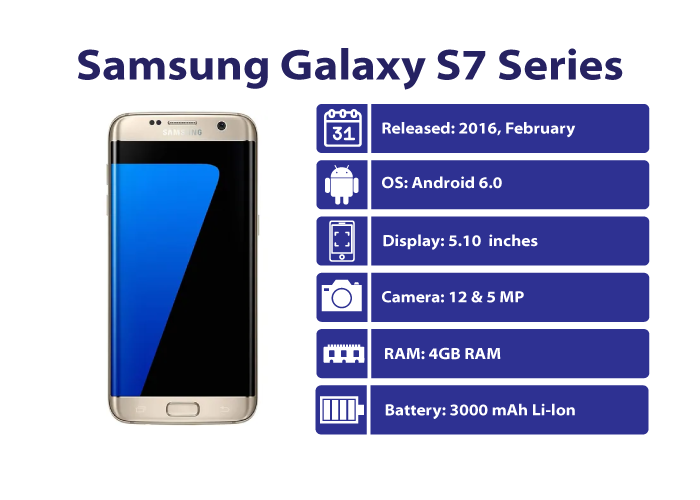The Samsung Galaxy S7 series, comprising the Galaxy S7 and Galaxy S7 Edge, was released in March 2016, representing a significant refinement over its predecessors with improvements in design, performance, and camera capabilities. Here’s a review of the Samsung Galaxy S7 series:
Design: The Galaxy S7 series retained the sleek and premium design language of its predecessors while introducing refinements such as a more rounded back and slimmer bezels. Both the Galaxy S7 and S7 Edge featured a combination of metal and glass construction, giving them a premium look and feel. The Galaxy S7 Edge stood out with its dual-curved display, which not only enhanced aesthetics but also provided additional functionality with Edge Panels for quick access to apps and shortcuts.
Display: The Galaxy S7 featured a 5.1-inch Quad HD Super AMOLED display, while the Galaxy S7 Edge boasted a larger 5.5-inch curved Quad HD Super AMOLED display. Both displays offered vibrant colors, deep blacks, and excellent contrast ratios, providing an immersive viewing experience for multimedia content, gaming, and browsing.
Performance: Powered by either a Qualcomm Snapdragon 820 or Exynos 8890 processor (depending on the region) and 4GB of RAM, the Galaxy S7 series delivered smooth and responsive performance. The devices handled everyday tasks with ease and could handle demanding apps and games without significant lag or stuttering.
Camera: The Galaxy S7 series introduced significant improvements to the camera system, featuring a 12-megapixel rear camera with Dual Pixel technology. This technology improved autofocus speed and low-light performance, resulting in sharp and detailed photos even in challenging lighting conditions. The cameras also supported features like optical image stabilization (OIS) and 4K video recording. The front-facing cameras were 5 megapixels and capable of capturing quality selfies.
Battery: The Galaxy S7 housed a 3000mAh battery, while the Galaxy S7 Edge featured a larger 3600mAh battery. Both devices offered all-day battery life for most users, with the Galaxy S7 Edge lasting longer due to its larger battery capacity. Both devices supported fast charging and wireless charging, providing convenient ways to recharge the battery quickly.
Software: At launch, the Galaxy S7 series ran Android 6.0 Marshmallow with Samsung’s TouchWiz user interface on top. The devices received subsequent updates to newer versions of Android, including Nougat and Oreo, along with security patches and feature enhancements.
Features: Additional features of the Galaxy S7 series included IP68 water and dust resistance, which allowed the devices to withstand immersion in water up to 1.5 meters for 30 minutes. Both devices also included a fingerprint scanner embedded in the home button for biometric authentication and Samsung Pay for mobile payments.
Conclusion: The Samsung Galaxy S7 series was widely praised for its refined design, excellent display, powerful performance, and impressive camera capabilities. It represented a significant step forward in smartphone technology and remained a popular choice for users even years after its release. Whether you opted for the standard Galaxy S7 or the more premium Galaxy S7 Edge, you were guaranteed a top-tier smartphone experience.


